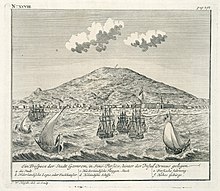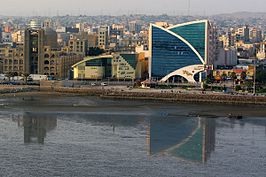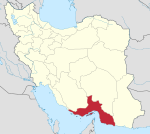Bandar Abbas
Bandar Abbas
Persian: بندر عباس گمبرون Gombroon | |
|---|---|
City | |
Taleghani Boulevard, Hindu temple, Panoramic, Islamic Azad University, Imamzadeh Seyed Mozafar | |
| Nickname: The Crab Port | |
| Coordinates: 27°11′46″N 56°17′16″E / 27.19611°N 56.28778°E[1] | |
| Country | Iran |
| Province | Hormozgan |
| County | Bandar Abbas |
| District | Central |
| Settled | prior to 600 BCE |
| Government | |
| • Type | Municipality |
| • Mayor | Mehdi Nobani [2] |
| Elevation | 9 m (30 ft) |
| Population (2016)[3] | |
| • Total | 526,648 |
| Time zone | UTC+3:30 (IRST) |
| Postal code | 79177 |
| Area code | (+98) 076 |
| Website | bandarabbas |
Bandar Abbas (Persian: بندر عباس; pronounced [bændæɾ æbːɑs] )[a] is a city in the Central District of Bandar Abbas County, Hormozgan province, Iran, serving as capital of the province, the county, and the district.[5] Bandar Abbas is a port on the southern coast of the country, on the Persian Gulf.
The city occupies a strategic position on the narrow Strait of Hormuz (just across from Musandam Governorate, Oman), and it is the location of the main base of the Iranian Navy.
Etymology
[edit]Bandar Abbas has always been a port, and as such its various names have all reflected this function. The most common name over time was Gameroon, with various spellings. In Henry Yule's dictionary of Anglo-Indian jargon two etymologies are given; the first derived from Turkish gümrük, "customhouse" (from Late Greek kommerkion, from Latin commercium, "commerce"). The second, which Yule found much more convincing, comes from Persian kamrūn, "shrimp" (in Portuguese: camarão, similar to the former Portuguese name).[6] Its current name derives from that of Abbas the Great[7] (r. 1588–1629) paired with bandar - "port", meaning "Port of Abbas".
History
[edit]Pre-Islamic history
[edit]The earliest record of Bandar Abbas is during the reign of Darius the Great (between 522 and 486 BCE). Darius's commander, Silacus, embarked from Bandar Abbas to India and the Red Sea. During Alexander's conquest of the Achaemenid Empire, Bandar Abbas was known under the name of Hormirzad.
Portuguese period
[edit]By the 16th century, Bandar Abbas was known as Gamrūn to the Persians. In 1565, a European navigator called it Bamdel Gombruc (that is, Bandar Gümrük, or "Customhouse Port"), citing this as the Persian and Turkish name. Bandar Abbas was conquered by the Portuguese in 1514, and was an important location to protect their commerce in the Persian Gulf and India.[8][9] They named the city Comorão, due to the presence of lobsters and crabs on its shores.

In 1614, Comorão was taken by Shah Abbas the Great from the Portuguese and renamed Bandar-e Abbas ("Port of Abbas"). Backed by the English Navy, Abbas developed the city (known to the English-speaking world as Gombraun) into a major port. By 1622, the Portuguese and English names had been officially combined to form Combrù or Combu, although the inhabitants still called it Bandar-e Abbas. Sir Thomas Herbert said the official English name was Gumbrown, but pronounced [gŏmrōōn]. He wrote in 1630 that "some (but I commend them not) write it Gamrou, others Gomrow, and othersome Cummeroon."[This quote needs a citation] By the 1670s, the city was known as Gameroon.
In 1622 CE, Abbas defeated Portuguese troops with the help of English troops and Iranian commander Imam Quli Khan. In honor of this victory Gumbroon was renamed Bandar Abbas Port. In the current division of Bandar Abbas in Hormozgan province and one of the most important strategic and commercial center is in the vicinity of the Persian Gulf and Oman Sea.

Dutch and English period
[edit]In 1625, a combined Anglo-Dutch fleet attacked the Portuguese at Bandar Abbas and took control of the trade posts. Soon, the Dutch East India Company outcompeted its English counterpart and eventually, from 1654 onwards, was in complete control of the local spice and silk trade, due to multiple english ships being taken, and the Action of 29 January 1654. The Dutch remained in complete control until 1765.[10]
Omani period
[edit]
Between 1794 and 1868, Bandar Abbas was under the control of the Sultanate of Oman and Zanzibar through a lease agreement with Persia. The details of the original lease apparently differed between the Arabic and Persian versions. The Omanis controlled the coastal stretch of some 100 miles from Sadij to Khamir, and inland about 30 miles, as far as Shamil. They also controlled the islands of Hormuz and Qeshm. In 1823, the Persians attempted to oust the Omanis, but the sultan managed to keep his hold on Bandar through bribery and tribute of the governor of Shiraz. In 1845–1846, an army under the governor general of Fars menaced Bandar to extort tribute, while another army under the governor of Kerman besieged Minab. The Omanis threatened to blockade Persia, but the British resident at Bushir convinced them to back down.[11]

The Persians recovered the city in 1854, while the sultan was in Zanzibar. Under British pressure following the Anglo-Persian War in 1856, Persia renewed Oman's lease on favourable terms. It was clarified that the leased territory belonged to the province of Fars and that the Persian flag would fly over Bandar Abbas. The rental rate was also increased. Under British pressure the agreement was renewed in 1868, but at a higher rate of rent and for a shorter duration. Two months after its renewal, the lease was cancelled by the Persian government, citing a clause which permitted its termination if the sultan of Oman were overthrown.[11]
Contemporary history
[edit]An earthquake in July 1902 damaged parts of the city, including the governor's house and the customs office, and nearby Qeshm Island.[12]
Mohammad Reza Shah Pahlavi paid particular attention to Bandar Abbas as a strategic port and during his time the government invested huge amounts of capital in the infrastructure.
Bandar Abbas serves as a major shipping point, mostly for imports, and has a long history of trade with India, particularly the port of Surat. Thousands of tourists visit the city and nearby islands including Qeshm and Hormuz every year.
Before initial plans to develop it as a major harbor, Bandar Abbas was a small fishing port with approximately 17,000 residents in 1955. By 2001, it had grown into a major city. It has a population of 450,000 (2011 estimate).
Demographics
[edit]Language
[edit]Original Bandaris (residents of Bandar Abbas) speak Bandari (بندری), a variety of Persian similar to neighboring Achomi and Dialects of Fars, and distinct from New Persian.[13] Bandari has loanwords from various European languages (e.g. tawāl, "towel") and some from Arabic (e.g. atā [اتى], "to come"), Persian and Balochi.[14]
Population
[edit]| Year | Pop. | ±% p.a. |
|---|---|---|
| 1986 | 201,642 | — |
| 1991 | 249,504 | +4.35% |
| 1996 | 273,578 | +1.86% |
| 2006 | 367,508 | +3.00% |
| 2011 | 435,751 | +3.47% |
| 2016 | 526,648 | +3.86% |
| source:[16] | ||
At the time of the 2006 National Census, the city's population was 367,508 in 89,404 households.[17] The following census in 2011 counted 435,751 people in 118,336 households.[18] The 2016 census measured the population of the city as 526,648 people in 152,682 households.[3]
Immigration
[edit]The city of Bandar Abbas is an immigrant-friendly city that has hosted all Iranian ethnic groups. Most of the emigrants living in Bandar Abbas city have chosen individual migration at the beginning of their migration, in other words, after finding employment opportunities in Bandar Abbas city, most of the emigrants entered this city with the intention of taking up a job opportunity individually, but with the passage of time and the feeling of job security and providing housing, they have also moved their families to Bandar Abbas. Iranians from the regions of Azarbayejan, Kurdistan, Luristan, Baluchistan, Kerman, Yazd, Isfahan, Fars, Gilan and Mazanadaran all contribute to economy and trade of the city.[19]
Geography
[edit]Location
[edit]
Bandar Abbas is situated on flat ground with an average altitude of 9 metres (30 ft) above sea level. The nearest elevated areas are Mt. Geno, 17 kilometres (11 mi) to the north, and Mt. Pooladi, 16 kilometres (9.9 mi) to the northwest of the city. The closest river to Bandar Abbas is the River Shoor, which rises on Mt. Geno and flows into the Persian Gulf, 10 kilometres (6.2 mi) east of the city. South of the city is the island of Qeshm.[citation needed]
Climate
[edit]Bandar Abbas has a hot desert climate (Köppen climate classification BWh). Maximum temperature in summers can reach 49 °C (120 °F) while in winters the minimum temperature may drop to 5 °C (41 °F). The annual rainfall is around 170 millimetres (6.7 in) and the average relative humidity is 65%.
In the summer, Bandar Abbas sees some of the highest average dew points of any city in the world, averaging 27 °C (81 °F) and frequently exceeding 30 °C (86 °F). As a result, heat indices generally top 50 °C (122 °F) for most days during the summer.[20][21] This immense humidity causes summer diurnal ranges to be lower than in most desert climates, and is a result of air flow from the warm waters of the Persian Gulf.
| Climate data for Bandar Abbas (1957-2010) | |||||||||||||
|---|---|---|---|---|---|---|---|---|---|---|---|---|---|
| Month | Jan | Feb | Mar | Apr | May | Jun | Jul | Aug | Sep | Oct | Nov | Dec | Year |
| Record high °C (°F) | 32.0 (89.6) |
33.0 (91.4) |
39.0 (102.2) |
43.0 (109.4) |
47.0 (116.6) |
51.0 (123.8) |
48.0 (118.4) |
46.0 (114.8) |
45.0 (113.0) |
42.0 (107.6) |
38.0 (100.4) |
33.8 (92.8) |
51.0 (123.8) |
| Mean daily maximum °C (°F) | 23.3 (73.9) |
24.6 (76.3) |
27.7 (81.9) |
32.0 (89.6) |
36.6 (97.9) |
38.5 (101.3) |
38.3 (100.9) |
37.6 (99.7) |
36.8 (98.2) |
34.9 (94.8) |
30.3 (86.5) |
25.5 (77.9) |
32.2 (89.9) |
| Daily mean °C (°F) | 17.7 (63.9) |
19.4 (66.9) |
22.6 (72.7) |
26.5 (79.7) |
30.8 (87.4) |
33.4 (92.1) |
34.4 (93.9) |
33.9 (93.0) |
32.3 (90.1) |
29.3 (84.7) |
24.2 (75.6) |
19.6 (67.3) |
27.0 (80.6) |
| Mean daily minimum °C (°F) | 12.2 (54.0) |
14.2 (57.6) |
17.5 (63.5) |
21.1 (70.0) |
25.0 (77.0) |
28.2 (82.8) |
30.5 (86.9) |
30.2 (86.4) |
27.8 (82.0) |
23.7 (74.7) |
18.2 (64.8) |
13.7 (56.7) |
21.69 (71.04) |
| Record low °C (°F) | 3.0 (37.4) |
3.9 (39.0) |
6.8 (44.2) |
11.5 (52.7) |
17.0 (62.6) |
20.0 (68.0) |
24.0 (75.2) |
25.0 (77.0) |
20.5 (68.9) |
12.0 (53.6) |
6.0 (42.8) |
2.0 (35.6) |
2.0 (35.6) |
| Average precipitation mm (inches) | 49.2 (1.94) |
40.2 (1.58) |
34.9 (1.37) |
8.1 (0.32) |
2.8 (0.11) |
0.3 (0.01) |
1.0 (0.04) |
1.4 (0.06) |
0.4 (0.02) |
3.8 (0.15) |
5.4 (0.21) |
28.6 (1.13) |
176.1 (6.94) |
| Average precipitation days (≥ 1.0 mm) | 3.3 | 3.1 | 2.6 | 1.3 | 0.2 | 0.0 | 0.1 | 0.2 | 0.1 | 0.1 | 0.4 | 2.3 | 13.7 |
| Average relative humidity (%) | 64 | 68 | 67 | 64 | 61 | 64 | 68 | 69 | 67 | 64 | 61 | 63 | 65 |
| Average dew point °C (°F) | 10.8 (51.4) |
13.3 (55.9) |
16.2 (61.2) |
19.1 (66.4) |
22.4 (72.3) |
25.6 (78.1) |
27.6 (81.7) |
27.4 (81.3) |
25.4 (77.7) |
21.8 (71.2) |
16.2 (61.2) |
12.4 (54.3) |
19.8 (67.6) |
| Mean monthly sunshine hours | 220.1 | 211.9 | 232.5 | 242.4 | 312.7 | 302.2 | 264.6 | 270.1 | 270.1 | 283.4 | 251.2 | 228.8 | 3,090 |
| Source: IRIMO (1957–2010)[22][23] | |||||||||||||
Economy
[edit]
The city is a producer of dates, citrus, tobacco and factory goods (such as canned tuna). Minerals such as Yellow cake uranium from the Gchine (Gachin) mine is extracted by around 20 tonnes per year.[24] Bandar Abbas is the site of a Chinese-built cruise missile production facility for the manufacture and upgrade of Silkworm (CSS-N-2) cruise missiles.[25]
Bandar Abbas exports transit goods, dates, citrus, tobacco, fishery. The city was formerly famous for its export of Iranian pottery, and was known in the west as "goombroon". "Goombroon ware" was the original porcelain imported to England from Goombroon in the early 20th century. It was later replaced by china ware imported from China. Kaolin was the mineral from which the porcelain was made.[26]
Transportation
[edit]
Air
[edit]Bandar Abbas International Airport has capacity and facilities for landing large transport airplanes.
Roads
[edit]Bandar Abbas is accessible via the following highways:
 Bandar Abbas-Sirjan, 300 kilometres (190 mi) to the northeast.
Bandar Abbas-Sirjan, 300 kilometres (190 mi) to the northeast.- Bandar Abbas-Kerman, 484 kilometres (301 mi) to the northeast.
- Bandar Abbas-Shiraz, 650 kilometres (400 mi) to the north.
- Bandar Abbas-Zahedan, 722 kilometres (449 mi) to the east.
Rail
[edit]Since 1993, Bandar Abbas has been the southern terminus of Islamic Republic of Iran Railways' main North–South corridor that links it to Yazd, Qom, Tehran and Qazvin to the north.[citation needed]
Education
[edit]
Universities
[edit]- Bandar Abbas University of Medical Sciences
- University of Hormozgan
- Islamic Azad University of Bandar Abbas
- Payame Noor University of Bandar Abbas
- Amir Kabir university of technology, Bandar Abbas Branch
- University of Applied Science and Technology, Bandar Abbas Branch
Sports
[edit]Aluminium Hormozgan is Bandar Abbas's main football (soccer) team. The team was founded in 2006. In 2012 they were promoted to the Iran Pro League but after their first season there they were relegated back to the Azadegan League where they currently play. Bander Abbas also has a second less supported team, Shahrdari Bandar Abbas, which was founded in 2005 and is the municipality's team.[citation needed]
See also
[edit]Notes
[edit]- ^ Also romanized as Bandar-e ‘Abbās (Port of Abbas). Bandar Abbas has been romanized as Bandar ‘Abbās and as Bandar ‘Abbāsī. It has also been referred to as Jaroon by the Arabs and Cameron by the English. Bandar Abbas was formerly known as Cambarão and Porto Comorão by Portuguese traders, as Gombroon by English traders and as Gamrun or Gumrun by Dutch merchants[4]
References
[edit]- ^ OpenStreetMap contributors (4 September 2023). "Bandar Abbas, Bandar Abbas County" (Map). OpenStreetMap (in Persian). Retrieved 4 September 2023.
- ^ "Bandar Abbas, Bandar Abbas to exchange knowledge". 2 November 2021.
- ^ a b "Census of the Islamic Republic of Iran, 1395 (2016)". AMAR (in Persian). The Statistical Center of Iran. p. 22. Archived from the original (Excel) on 5 May 2022. Retrieved 19 December 2022.
- ^ Bandar Abbas can be found at GEOnet Names Server, at this link, by opening the Advanced Search box, entering "-3055107" in the "Unique Feature Id" form, and clicking on "Search Database".
- ^ Habibi, Hassan (12 September 1990). "Approval of the organization and chain of citizenship of elements and units of Hormozgan province's national divisions centered in Bandar Abbas city". Laws and Regulations Portal of the Islamic Republic of Iran (in Persian). Ministry of Interior, Defense Political Commission of the Government Council. Archived from the original on 24 February 2022. Retrieved 9 February 2024.
- ^ "Hobson Jobson Dictionary". Archived from the original on 28 July 2013.
- ^ electricpulp.com. "BANDAR-E ʿABBAS(I) i. The City – Encyclopaedia Iranica". www.iranicaonline.org.
- ^ Iran tourism and touring official website, Bandar Abbas
- ^ SalamIranProvince of Bandar Abbas
- ^ Donald Hawley: The Trucial States, Ardent Media, 1970, pp. 76.
- ^ a b Lawrence G. Potter, "The Consolidation of Iran's Frontier on the Persian Gulf in the Nineteenth Century", in Roxane Farmanfarmaian (ed.), War and Peace in Qajar Persia: Implications Past and Present (Routledge: 2008), pp. 125–48.
- ^ "Latest intelligence – Earthquake shocks on the Persian Gulf". The Times. No. 36824. 19 July 1902. p. 7.
- ^ "BANDARI". Encyclopædia Iranica. Archived from the original on 29 April 2011. Retrieved 27 September 2021.
- ^ "Persian Gulf, Governery of BandarAbbas - خلیج فارس، فرمانداری بندرعباس". www.pgba.ir. Retrieved 19 September 2021.
- ^ "Language distribution: Hormozgan Province". Iran Atlas. Archived from the original on 25 September 2021. Retrieved 27 September 2021.
- ^ Iran: Provinces and Cities population statistics
- ^ "Census of the Islamic Republic of Iran, 1385 (2006)". AMAR (in Persian). The Statistical Center of Iran. p. 22. Archived from the original (Excel) on 20 September 2011. Retrieved 25 September 2022.
- ^ "Census of the Islamic Republic of Iran, 1390 (2011)". Syracuse University (in Persian). The Statistical Center of Iran. p. 22. Archived from the original (Excel) on 17 January 2023. Retrieved 19 December 2022.
- ^ "گروه های مهاجر شهر بندرعباس", Noor (in Persian) (68): 133–144, retrieved 9 April 2024
- ^ "Weather History for Bandarabbass, Iran - Weather Underground". www.wunderground.com.
- ^ "Weather History for Bandarabbass, Iran - Weather Underground". www.wunderground.com.
- ^ "Bandar Abbas 1961–1990". National Oceanic and Atmospheric Administration. Retrieved 29 December 2012.
- ^ "40875: Bandarabbass (Iran)". ogimet.com. OGIMET. 11 January 2021. Retrieved 11 January 2021.
- ^ "Gchine Uranium Mine (Gachin Uranium Mine; Bandar Abbas Uranium Mine), Bandar Abbas County, Hormozgan Province, Iran".
- ^ "Bandar Abbas N27°11' E56°16'". Federation of American Scientists. Retrieved 5 October 2014.
- ^ Mrs G MacKenzie (21 February 1947). "Pottery Production Can Be Mastered with Simple Tools". The Coast News. Halfmoon Bay, British Columbia. Archived from the original on 4 March 2014. Retrieved 5 October 2014.
Further reading
[edit]External links
[edit] Media related to Bandar Abbas at Wikimedia Commons
Media related to Bandar Abbas at Wikimedia Commons- Bandar Abbas on Iran Chamber Society (www.iranchamber.com)
- Bandar Abbas Port
- www.hums.ac.ir/english/province/hormozgan english/bandar_abbas.htm








